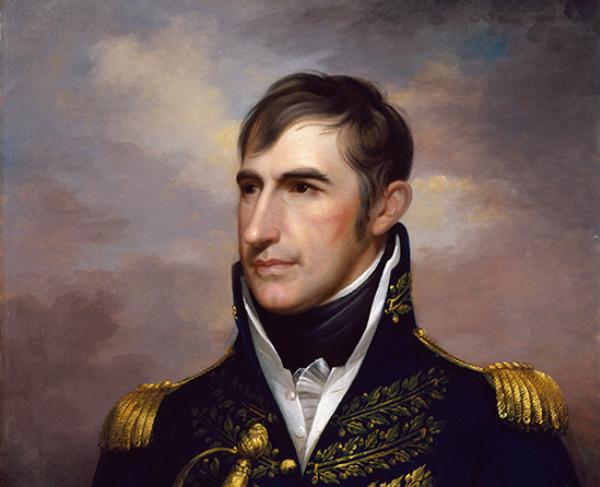William Henry Harrison: Tippecanoe and Political Spin Too

During the 17th and 18th centuries, the colony, and later state, of Virginia was dominated socially, economically and politically by the owners of large tobacco plantations. It was from among this class of American aristocrats-wealthy (though often in debt), slave owning, ardently anti-British-that the leaders of the American Revolution, and ultimately, four of the first five U.S. presidents came.

The Revolutionary generation passed along its ideological worldview to its offspring. The master of Berkeley Plantation, Benjamin Harrison V, was an associate of Washington, Jefferson and Henry Knox; a signer of the Declaration; and three-term governor of Virginia. Benjamin's youngest son, William Henry, attended college and briefly studied medicine, before joining the military in 1791 at the age of 18.
The newly commissioned Ensign William Harrison's first assignment was that of a recruiter in Philadelphia. He raised 80 men, leading them to Fort Pitt and then down the Ohio in flatboats. The company arrived in Fort Washington (Cincinnati) in November of 1791, just in time to meet the survivors of St. Claire's Defeat. When Anthony Wayne replaced St. Claire as major general of the army in 1793, young Harrison became one of Wayne's aides-de-camp and got his first combat experience at the Battle of Fallen Timbers. In the years after the 1795 signing of the Treaty of Greenville, he married Anna Symmes, resigned his commission and re-entered civilian life.
Harrison was appointed governor of the newly formed Indiana Territory at age 27. The family moved to Vincennes, the territorial capital, and constructed an estate, which they named Grouseland. The mansion still stands today, operated and maintained as a museum by the Grouseland Foundation, Inc.
Harrison's rise to power in the Indiana Territory paralleled that of a Shawnee mystic named Tenskwatawa, or the Open Door, known to whites simply as the Shawnee Prophet. The Prophet led a Native revivalist movement that became increasingly militant, as one treaty after another sliced away Native territory. Anger over land sales eventually led to the Battle of Tippecanoe on November 7, 1811.
The two-hour, pre-dawn battle was Harrison's first combat command. The army suffered a casualty rate of more than 20 percent, but held the field and accomplished its narrowly drawn mission of causing the evacuation and dispersal of the population of Prophet's Town. Though initially viewed by some as a defeat, the outcome of the battle, along with his subsequent military success, allowed the resilient and adaptable Harrison to spin the fight into a great strategic victory and use it to launch a national political career.

Harrison resigned the governorship and took command of the Army of the Northwest at the beginning of the War of 1812. While his wartime success cemented his reputation, he was, like Theodore Roosevelt, always remembered for a single brief event.
The political season of 1840 began almost a year early, with Whigs and their supporters bludgeoning the hapless "Martin Van Ruin" as an elitist snob responsible for the economic woes of the country. The Whig convention in Harrisburg passed over the party's establishment figures — Henry Clay and Daniel Webster — to nominate Harrison ("Old Tippecanoe"), along with John Tyler ("Tyler, too"), as its presidential ticket. Harrison represented the rising political power of the West, and when Democrats, intending insult, suggested that Old Tipp would be better off pensioned and given a barrel of hard cider to drink while sitting in front of his log cabin, the campaign gladly accepted the smear as a gift, and the "Log Cabin and Hard Cider Campaign" was born. Almost overnight, log cabins ( some mobile and pulled by oxen), coon skins and hard cider became the symbols of an energized Whig Party.
What may stand as the largest event ever to take place at the Tippecanoe Battlefield was held May 29-30, 1840, when the Whig Party and its presidential ticket held a massive rally. Most forms of travel other than foot or horseback were impossible. Nevertheless, thousands of rally-goers made their way to the battlefield. "Fifteen acres of men" guessed one paper, all housed in a tent three quarters of a mile long, dined on beef roasted over a large pit on the grounds. Hard cider was only one of the intoxicating beverages served. Six bands played, while attendees' horses lounged on a temporary, 300-acre grazing farm.

The "Carnival Campaign" went on to sweep the 1840 election in landslide fashion. Harrison and Tyler carried 19 of the 26 states in an election in which voter turnout increased 38 percent over 1836 levels.
Harrison's 8,445-word inaugural address is the longest in U.S. history, but his tenure in office remains the shortest. Falling ill about three weeks later, the oldest man elected president up to that time became the first president to die in office.
Related Battles
189
120




